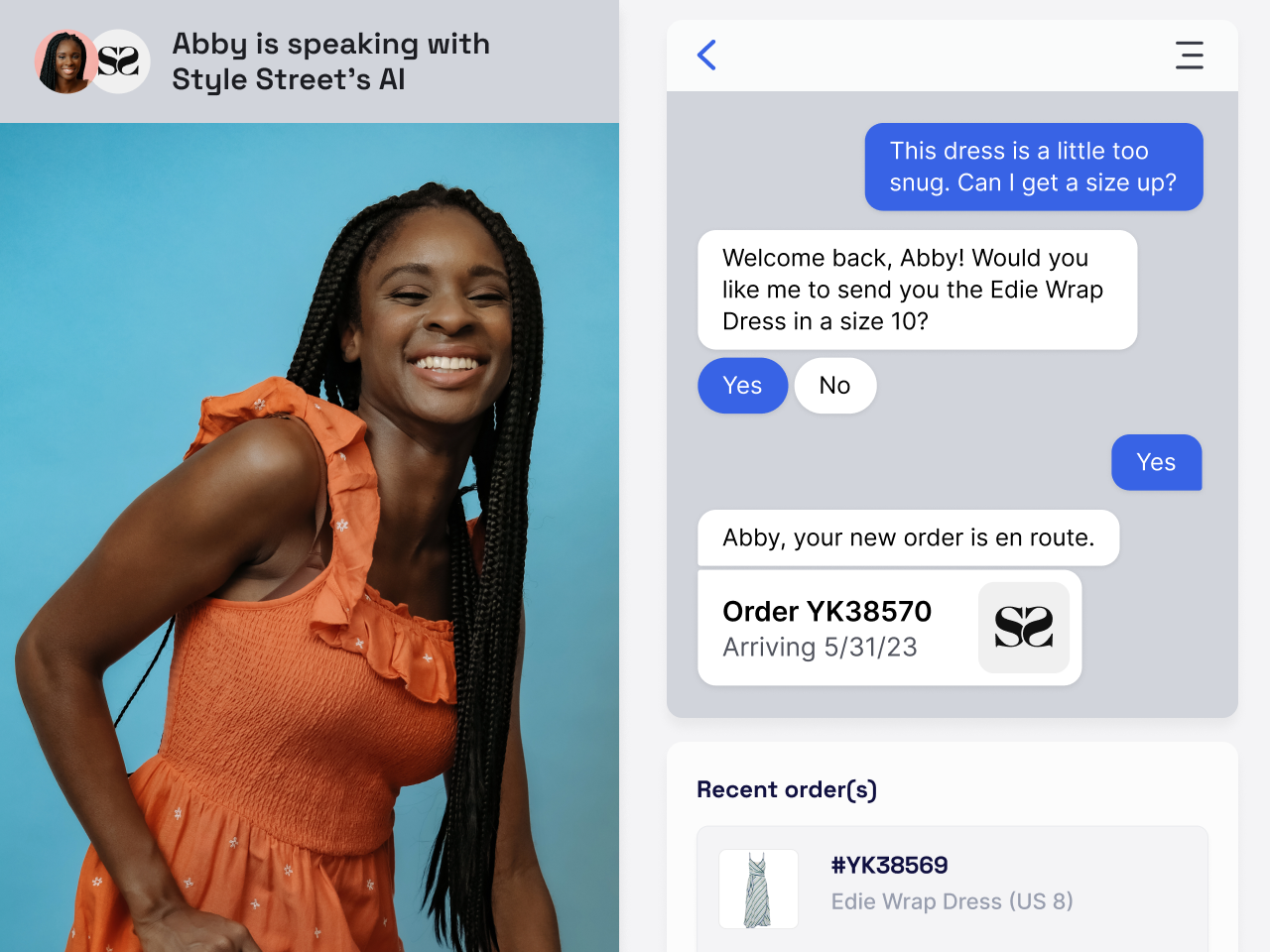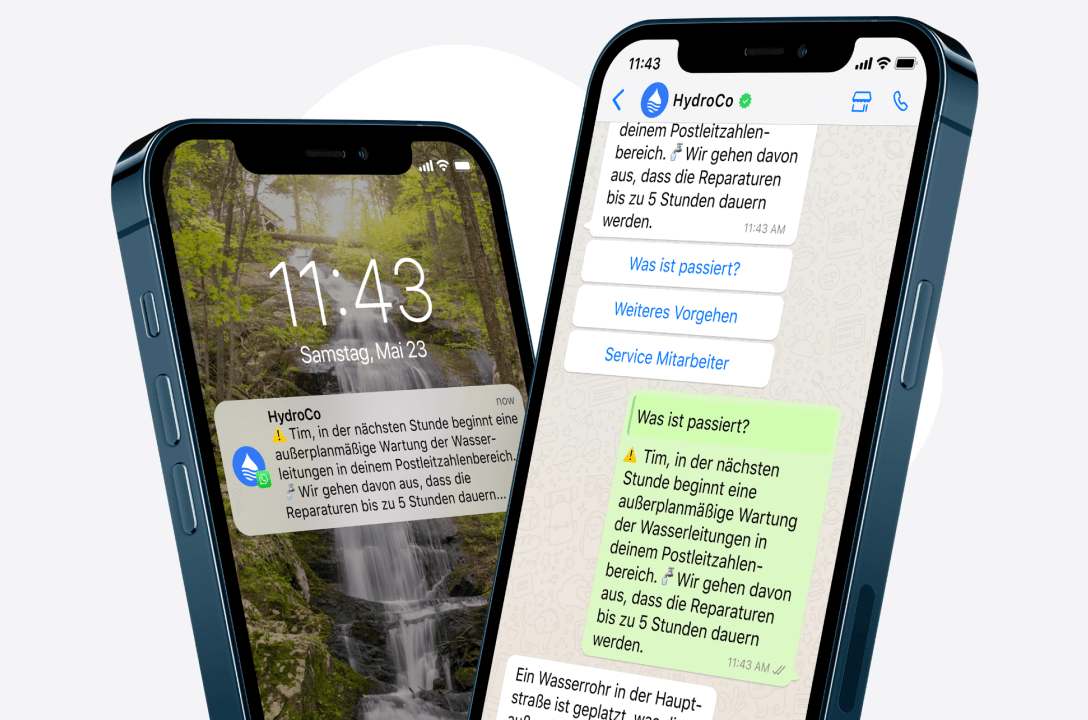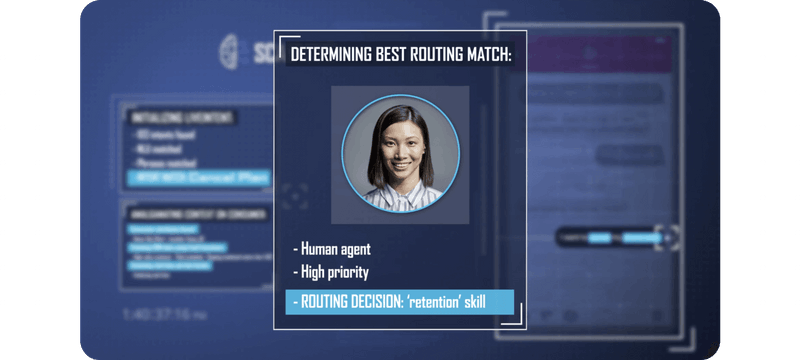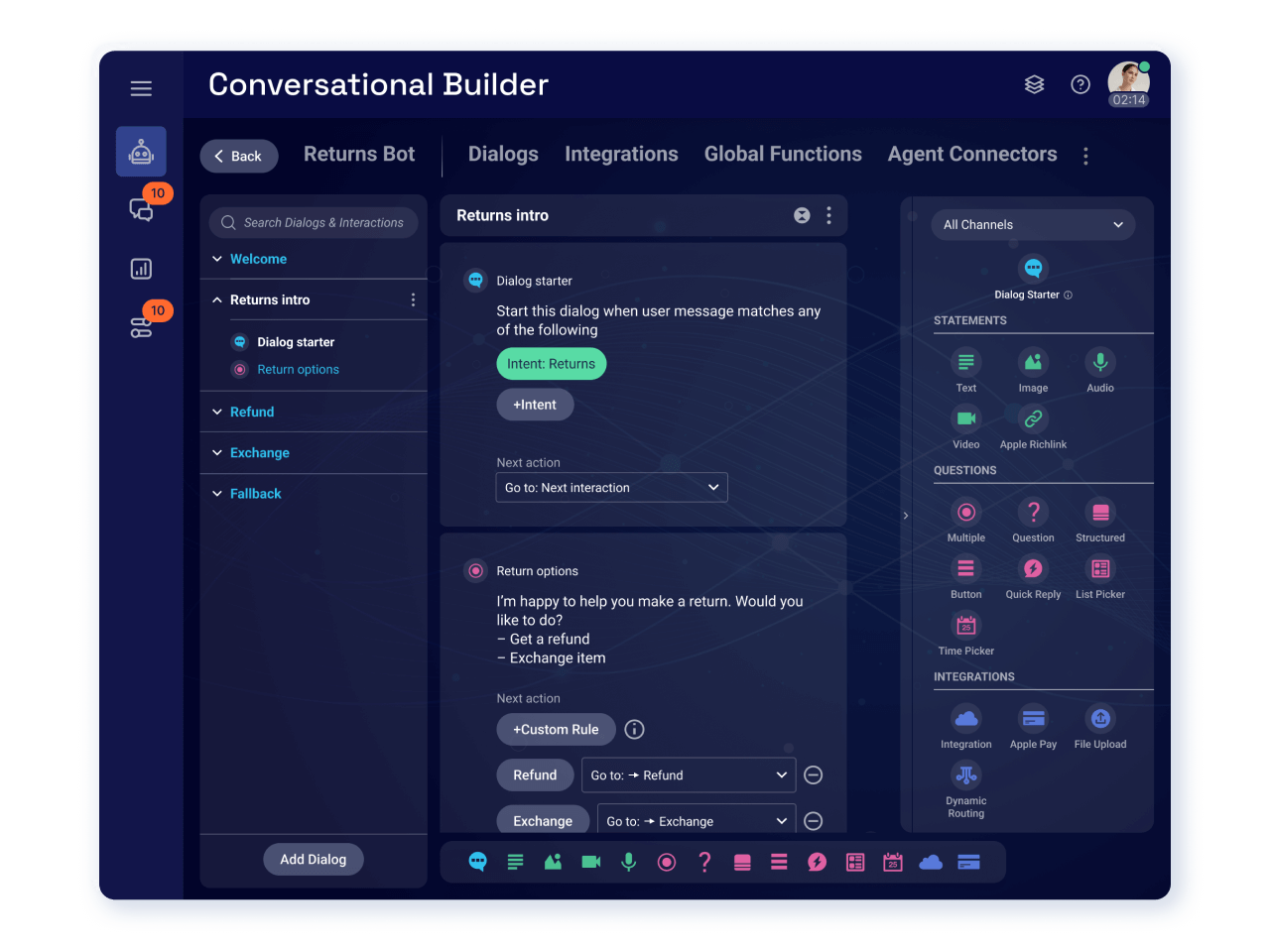GUIDEEverything you need to know about AI chatbots
Read on as we explore how AI chatbots are not only revolutionizing customer experiences, but becoming indispensable tools in driving business efficiency and success.
Demo LivePerson’s AI approachExplore the guide below
We’re riding the wave of an on-demand revolution — where a hot meal or the latest bestseller lands at our doorstep in mere minutes. This era of instant gratification, powered by rapid technological progress, raises the bar for customer happiness. So, what’s the secret to unlocking this new level of customer contentment? Enter the era of the AI chatbot — the new champions of customer service, heralding a transformative era in contact centers and overall business operations.
These intelligent virtual assistants are more than just a response to the demand for speed and efficiency; they’re redefining the essence of modern customer support. AI chatbots bring a unique blend of immediacy and personalization, transforming customer interactions from mere transactions to meaningful, personalized engagements.
Beyond streamlining customer service, AI chatbots are reshaping business models and operational strategies. They extend their utility to data-driven insights, automation of routine tasks, and enabling companies to focus on innovation and growth. By harnessing the power of AI chatbots, businesses are transitioning to a more proactive and adaptive operational model, aligning closely with evolving customer expectations and market dynamics.
Explore where we came from and where we’re going
The evolution of bot building
In the realm of digital assistance, chatbots are undergoing a transformative evolution. Traditionally, chatbots have been categorized as either rule-based, relying on pre-programmed responses, or AI-driven, utilizing natural language understanding (NLU) to trigger dialogues based on intent. However, this landscape is being reshaped by the advent of generative AI, marking a significant shift from the conventional bot-building paradigm.
As we venture further into the era of generative AI, the distinction between programmed virtual agents and an adaptive conversational partner is becoming increasingly nuanced. The latest developments in generative AI are leading us towards a hybrid approach, blending natural dialogues with programmed actions. This approach not only makes interactions feel more organic but also ensures they drive towards desired outcomes.
Looking ahead, chatbots are moving toward a fully generative AI-based system, characterized by probabilistic dialogues fine-tuned with Reinforcement Learning with Human Feedback (RLHF). This advanced system will be capable of handling diverse conversations and actions, supported by orchestrated fallback options for specific scenarios or safety needs.
In this evolving landscape, AI-powered chatbots are expanding their capabilities far beyond what rule-based systems could offer, setting new standards for customer engagement and conversational experiences.
How do AI chatbots work?
You’ve no doubt encountered an AI chatbot before — but what’s going on behind the scenes? How do you go from typing a message to getting a thoughtful, considered response from a robot? In a nutshell, AI chatbots work by using artificial intelligence, natural language processing (NLP), and machine learning techniques to understand and respond to human text or voice inputs. We’re here to break the process down into easy-to-digest steps.
AI chatbots require access to a vast amount of data to function effectively. Depending on their intended use, they may use pre-existing datasets, customer support logs, or other sources of textual training data to learn from. Some chatbots also have access to external data sources to fetch real-time information. For instance, LivePerson’s chatbots are trained on diverse datasets, enabling them to understand a wide range of customer inquiries.
Natural Language Processing (NLP) is a subfield of AI that focuses on the interaction between computers and human language models. NLP relies on the development of algorithms and models that enable machines to understand, interpret, and generate human language in a way that’s both meaningful and contextually relevant. LivePerson’s AI chatbots leverage advanced NLP to accurately interpret customer intent and provide an appropriate response.
So how does NLP factor into how AI chatbots work? Basically, it’s the key that helps the chatbot to understand and process human prompts. This includes elements like tokenization (breaking text into words or phrases), part-of-speech tagging, named entity recognition, and sentiment analysis.
Here’s another key term that comes up a lot in the AI chatbot realm — but what does it mean? Like NLP, machine learning (ML) is another algorithm and language model-based subfield of AI — only ML’s job is to help computers learn and make predictions or decisions based on training data. Instead of relying on explicit programming, machine learning systems use data to recognize patterns and make intelligent inferences.
Machine learning algorithms, like neural networks, are used to train chatbots. The chatbots learn from the data by recognizing patterns in the text. Some chatbots also use reinforcement learning to improve their responses over time based on user feedback. LivePerson’s AI chatbots, for example, use this technology to improve their interactions continually, learning from previous conversations to enhance future responses.
Next, the chatbot needs to figure out what you want by analyzing your input text. At this stage, it identifies nouns, verbs, phrases, and context to understand what the user is asking or trying to accomplish. LivePerson’s technology excels in this area, accurately deciphering customer needs to provide effective solutions.




Why your business needs an AI chatbot
We know they’re helpful and efficient, but does your business really need an AI chatbot? The data says yes. There are some stats and facts to back up the benefits that chatbots provide to businesses — let’s take a look.

24/7 availability & instant response
Chatbots provide uninterrupted customer support, ensuring customers receive immediate responses any time of the day. This capability to assist customers is crucial in today’s fast-paced world, where timely responses are not just appreciated but expected.
See how it works with LivePerson

Cost savings
By handling routine tasks, chatbots allow human agents to focus on higher-value tasks, contributing to overall agent satisfaction and reducing turnover. The ability for chatbots to automate responses and streamline customer interactions leads to increased conversation data which in turn can be used to identify CX problems early and implement solutions before they become costly.
See how it works with LivePerson

Efficient customer support
Chatbots efficiently manage basic queries, allowing human agents to concentrate on more complex issues. This division of labor enhances overall customer service efficiency, ensuring that each interaction is handled in the most effective way possible.
See how it works with LivePerson

Scalability
Chatbots are key to scaling customer support efforts and managing increasing volumes of customer conversations without necessitating a proportional increase in staff. Their flexibility and adaptability make them ideal for businesses experiencing growth or seasonal spikes in customer queries.
See how it works with LivePerson

Personalization
A conversational bot also excels in providing personalized recommendations and content, adapting responses based on user interactions. This level of personalization improves the overall customer experience, making interactions more relevant and engaging.
See how it works with LivePerson

Data analysis & insights
Chatbots paired with AI-empowered conversational intelligence can help you discover key insights from customer dialogues. Using advanced analytics, conversational intelligence can measure the effectiveness of AI-powered chatbots in customer service. Businesses can then use these insights to transform conversations into actionable data, enabling a deeper understanding of customer/user behavior and preferences across multiple channels.


Increased sales & conversions
Chatbots play a pivotal role in enhancing sales and conversion rates by assisting in product recommendations and lead generation. Their ability to provide timely and relevant suggestions makes them valuable assets in driving revenue growth.
See how it works with LivePerson

Consistent brand messaging
Chatbots deliver accurate and uniform information, ensuring a consistent brand message across all customer interactions. This consistency is vital for maintaining brand integrity and trust with customers.
See how it works with LivePerson

Enhanced user engagement
By offering interactive and conversational experiences, chatbots significantly enhance user engagement. Their dynamic interactions contribute to building stronger customer relationships and loyalty.
See how it works with LivePerson

Global reach
With their multilingual capabilities, chatbots enable businesses to communicate effectively with a diverse, global audience. This feature is particularly valuable for companies looking to expand their market reach and cater to customers in different languages.
See how it works with LivePerson
Interesting stats & facts about AI chatbots
• A report by IBM states that chatbots can resolve up to 80% of routine customer inquiries, significantly improving efficiency.
• Statistics from Outgrow suggest business leaders claim that on average, chatbots improve sales by 67%.
• Accenture reports that 91% of consumers are more likely to shop with brands that offer personalized recommendations.
• Gartner predicts that by 2027, chatbots will become the primary customer service channel for roughly a quarter of organizations.
• According to Salesforce, 83% of customers expect an immediate response from brands — chatbots can meet this demand effectively.
• According to LivePerson’s report on the State of Customer Conversations 2024, 2 out of every 3 consumers expect the way they work with businesses to improve over the next five years, thanks to AI.
Read the State of Customer Conversations report
Chatbot dos and don’ts
Much as there are some best practices to follow when diving into the world of chatbots, there are also some things to avoid. We’ve assembled a cheat sheet of dos and don’ts for quick reference!
LivePerson’s conversational advantage: Advanced AI chatbot solutions
In the evolving landscape of customer engagement, AI chatbots are not just about responding to queries — they’re about creating meaningful, dynamic interactions. This is where LivePerson’s suite of advanced conversational AI solutions comes into play, offering an array of tools designed to revolutionize how businesses connect with their customers. These solutions are engineered to elevate every aspect of the conversational experience:
Conversation Orchestrator
Conversation Manager
AI Annotator
Generative AI
Integrations
Conversation Builder
Conversation Orchestrator
Personalized customer journeys at scale
LivePerson’s Conversation Orchestrator overcomes the challenge of impersonal digital interactions by enabling highly personalized customer journeys. By analyzing interactions in real-time, it ensures responses are both relevant and impactful, countering the notion that chatbots lack the personal touch.
Learn moreConversation Manager
Seamless bot-to-human handoffs
Acknowledging the limit of AI in handling complex queries, Conversation Manager ensures a seamless transition between chatbots and human agents. It upholds high-quality service by balancing sophisticated AI with the irreplaceable value of human interaction.
Learn moreAI Annotator
Enhancing chatbot intelligence
Addressing concerns about stagnant or irrelevant responses, the AI Annotator continually enhances the chatbot’s intelligence with real-time human agent feedback. With a fraction of the effort, teams can use this tool to improve intent models and help chatbots learn or evolve.
Learn moreGenerative AI
Crafting rich, dynamic conversations
To combat the critique of robotic and monotonous chatbot conversations, Generative AI tools craft rich, dynamic dialogues using brand-specific data, conversational context, and prompts. This technology elevates the chatbot experience to near-human levels, providing engaging and contextually rich interactions.
Learn moreIntegrations
A unified customer view
LivePerson’s integrations tackle the challenge of isolated and uninformed chatbot responses. By connecting with CRM systems and other platforms, we offer a unified customer view, ensuring chatbots provide informed and relevant interactions.
Learn moreConversation Builder
Low-code chatbot development
Overcoming the barrier of technical complexity in chatbot development, Conversation Builder allows businesses of all sizes to easily design and deploy AI chatbots. It democratizes the creation process, showing that advanced chatbot solutions are accessible to all businesses, regardless of their technical expertise.
Learn more





AI chatbots in the real world
From addressing the unique challenges of a global pandemic to revolutionizing traditional business models, AI chatbots are proving their worth in diverse settings. These success stories illustrate how LivePerson’s AI-powered bots have been instrumental in enhancing customer experiences, streamlining operations, and driving remarkable business growth in different sectors.

LivePerson Case Study
David’s Bridal: Navigating COVID-19 challenges with AI assistance
David’s Bridal adapted to the unprecedented challenges of COVID-19 by employing AI chatbot technology. The chatbot provided crucial support in managing customer inquiries during this period, ensuring seamless communication and helping to maintain a high level of service despite the pandemic’s constraints.

livePerson case study
Virgin Media: Transforming telecommunications with conversational AI
Virgin Media’s adoption of AI chatbots redefined their customer engagement strategy, particularly in conversational selling. The AI implementation not only enhanced the customer buying experience but also led to a significant increase in sales efficiency, with a notable 40% rise in customer acquisition via messaging channels.

LivePerson case study
Bankwest: Streamlining customer interactions with precision
Bankwest successfully integrated AI chatbots into their support framework, revolutionizing their approach to customer service. The implementation led to a more efficient handling of customer inquiries, showcasing the chatbot’s ability to provide prompt and accurate responses, thus elevating customer satisfaction and operational efficiency.
Putting AI chatbots to work: A step-by-step approach
Integrating an AI chatbot into your business operations can significantly enhance efficiency and customer engagement. Here’s a basic checklist for building and optimizing your AI chatbot:
1. Define your objectives: Whether it’s improving customer support or increasing sales, clarity on your goals will guide the chatbot’s development.
2. Choose the right chatbot type: Decide between rule-based and AI-driven chatbots based on your needs. AI-driven chatbots are more versatile and can handle a broader range of tasks, especially those requiring understanding of complex queries.
3. Select a platform: Determine the most suitable platforms for deploying your chatbot, such as websites, messaging apps, or social media platforms. Consider where your customers are most active.
4. Data collection and preparation: Gather and organize relevant data to inform your chatbot’s responses. This might include FAQs, customer service logs, or external data sources for real-time information.
5. Choose the right technology stack: Select the appropriate natural language processing (NLP) frameworks and machine learning libraries that suit your chatbot’s intended complexity and capabilities.
6. Train your chatbot: Invest time in training your chatbot with relevant data and scenarios. Regularly update its knowledge base to reflect changes in user queries or business offerings.
7. Design conversational flows: Create dialogue scripts that are natural and engaging. Ensure these scripts align with your brand tone and effectively guide users to solutions.
8. Test and iterate: Rigorously test your chatbot in various scenarios to ensure it functions as intended. Collect user feedback to make continuous improvements.
9. Deploy your chatbot: Launch your chatbot on the selected platforms. Ensure it’s properly integrated with your existing systems for a seamless user experience.
10. Monitor and optimize: Continuously monitor performance and gather insights to enhance your chatbot’s responses and effectiveness.
11. Consider ethical and privacy aspects: Ensure your chatbot adheres to ethical standards and respects user privacy. Implement measures to prevent bias and protect user data.
12. Provide human backup: Establish a system for smoothly transitioning to human agents when the chatbot encounters limitations. This ensures that users always receive the help they need.
Getting the help you need with LP 360
While the steps to integrating an AI chatbot can seem daunting, LivePerson’s LP 360 offers a comprehensive solution that simplifies this journey. LP 360 is designed to manage your end-to-end conversation strategy, taking the complexity out of deploying AI-powered chatbots. From defining objectives to designing conversational flows, and from deployment to continuous optimization, LP 360 covers all aspects of reliable AI chatbot integration.

Accelerate time to value
With LP 360, businesses can leverage the full suite of LivePerson’s advanced tools and expertise without the need for extensive in-house resources. It offers a turnkey contact-center-as-a-service solution that encompasses everything from conversation design and AI training to ongoing management and optimization, ensuring your own chatbot is not only powerful and effective but also aligned with your business goals and ethical standards. LP 360 is the ideal choice for businesses looking to seamlessly integrate AI chatbots and transform their customer engagement strategy with minimal hassle and maximum efficiency.
SEAMLESS INTEGRATION, REAL RESULTS
Unlocking new possibilities in AI with LivePerson
The role of AI chatbots in enhancing customer service and driving operational efficiency cannot be overstated. With their ability to provide 24/7 support and instantaneous responses, these bots are perfectly suited to meet the demands of today’s fast-paced, digital-first consumer landscape. They can offer significant cost savings by streamlining routine tasks and scale effortlessly to handle growing customer interactions, proving to be a wise investment for businesses looking toward the future.
A well-implemented AI chatbot brings a level of personalization and insightful data analysis that is crucial in understanding and satisfying customer needs. As chatbots continue to advance with enhanced natural language understanding and sophisticated data-driven insights, they are rapidly becoming the cornerstone of modern customer service strategies.
In this context, LivePerson’s Conversational Cloud® offers solutions that ensure your chatbot delivers customer engagement that is both efficient and deeply personalized. This capability enables businesses to stay ahead in an ever-changing market with support that’s always available and tailored to individual customer preferences.




















